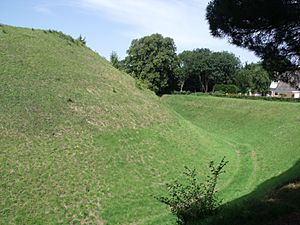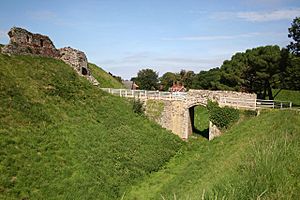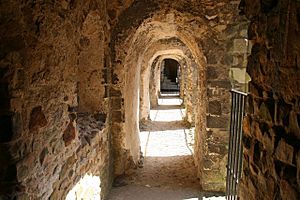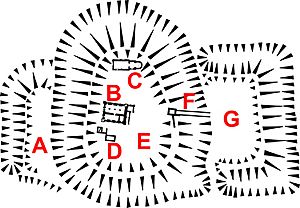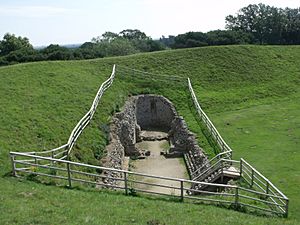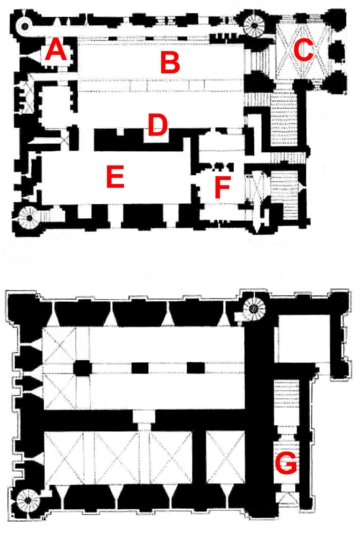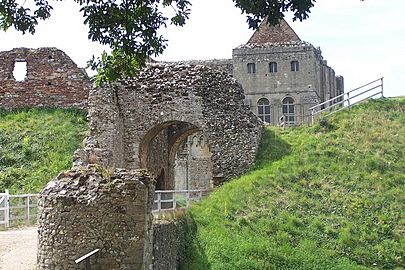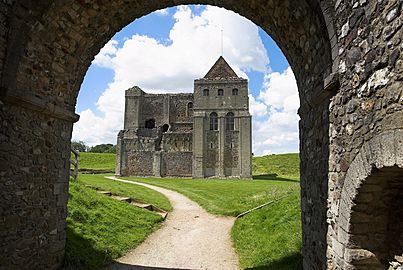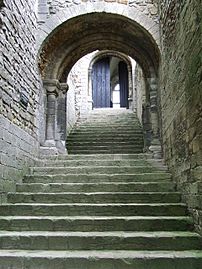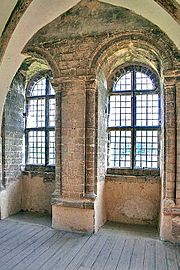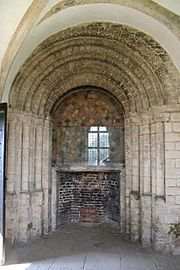Castle Rising Castle facts for kids
Quick facts for kids Castle Rising |
|
|---|---|
| Castle Rising, Norfolk, England | |
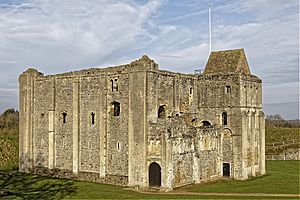
Castle Rising's keep, seen from the south-east, with its distinctive pilaster buttresses, and the forebuilding on the right
|
|
| Coordinates | 52°47′34″N 0°28′08″E / 52.7928°N 0.4689°E |
| Site information | |
| Owner | Lord Howard of Rising |
| Open to the public |
Yes |
| Condition | Ruins |
| Site history | |
| Built by | William d'Aubigny II |
| Events | Revolt of 1173–1174 |
Castle Rising is a ruined medieval fortress in the village of Castle Rising, Norfolk, England. It was built around 1138 by William d'Aubigny II. He was a powerful Norman noble who became the Earl of Arundel. With his new wealth, he built Castle Rising. It was both a strong fortress and a fancy hunting lodge, surrounded by a large deer park.
His family owned it for many years before it went to the de Montalt family in 1243. Later, Queen Isabella bought the castle. She lived there after she was no longer in charge of the country in 1330. Isabella made the castle bigger and lived like a queen. Her son, King Edward III, visited her there many times. After she died, the castle became part of the Duchy of Cornwall for Edward, the Black Prince.
By the 1400s, the castle was more important for hunting than for defense. It slowly fell apart. Even with new buildings, it was mostly ruined by the mid-1500s. King Henry VIII sold the castle to Thomas Howard, the Duke of Norfolk. Most of the castle buildings were then torn down.
In the 1800s, Mary and Fulke Greville Howard inherited the castle. They started to fix and restore it. Experts from the Victorian period studied the site, and it was opened to the public. In 1958, the government took care of the castle. They did more work to make it stable and studied its history. In 1998, English Heritage gave the castle's management back to its current owner, Baron Howard of Rising. It is still a popular place for tourists to visit today.
Castle Rising has three main areas called baileys. Each is protected by huge earth mounds. These earthworks cover about 5 hectares (12 acres). Experts Oliver Creighton and Robert Higham say they are some of the most impressive in Britain. Inside the main area is the great keep, which is like a tall tower. It might have been designed like Norwich Castle. The keep has amazing Romanesque designs. This includes pilaster buttresses and arches. Historians Beric Morley and David Gurney call it "one of the finest of all Norman keeps."
Contents
Castle History
Early Years: 1100s – 1200s
Castle Rising was built around 1138 by William d'Aubigny II. He was a rising noble who owned the nearby land of Snettisham. William married Adeliza of Louvain, the widow of King Henry I, in 1138. He became the Earl of Arundel in 1139. This made him very important. One writer at the time said he "became intolerably puffed up." With his new wealth, William built Castle Rising and New Buckenham Castle in Norfolk. He also made Arundel Castle in West Sussex bigger.
The castle was about 5 miles (8 km) from the port of King's Lynn. In the 1100s, people usually reached it by boat. A channel in the marshy Babingley River ran nearby. After the Norman conquest of England, the land was given to Bishop Odo. He might have used it as a local center. Many old Norman buildings were on the castle site. Norfolk was a rich area then, but the castle's spot was not important for war. It was only useful as a place for soldiers to gather. The land around it was not good for farming and had few people. William probably chose the site because it was cheap and easy to build a big castle and a large hunting park. Historian Richard Hulme says William built "a palatial hunting lodge."
Building Castle Rising took a lot of effort. It included three baileys with huge earth defenses and a stone keep. A deer park was built right behind the castle. As part of the project, the old village was moved north. It became a planned town next to the new castle. An old Norman chapel from around 1100 was inside the castle defenses. A new church, St Lawrence, was built in the new town. William also got permission from King Stephen to make coins at the castle in 1145. He also settled a community of Jewish people in the town.
We don't know how often William stayed at Castle Rising. He and his wife likely preferred their estates near Arundel. William and his family chose New Buckenham Castle as their main castle in Norfolk.
A long civil war, called the Anarchy, happened in England from 1138 to 1154. It was between King Stephen's followers and the Empress Matilda. The war ended when Matilda's son, Henry II, became king. William had supported Stephen, but he was loyal to Henry II after the war. He was allowed to keep his lands. However, Henry closed the coin mint at Castle Rising. The local Jewish community moved to King's Lynn.
A second quick building phase happened at the castle, probably in the 1170s. This was because of a big rebellion against Henry II. William supported the King and fought in the Battle of Fornham. Around this time, the earth defenses were made twice as high. The ground level of the west bailey was also raised to form a platform.
The castle was passed down to William's son, William d'Albini III, then to his son, William IV, and grandson, William V. William V died in 1224, leaving it to his brother Hugh. By this time, the chapel inside the castle was probably no longer used for religious services. The top 3.7 meters (12 feet) of the keep's walls look different from the rest. One idea is that the keep was not finished during William II's life. The final work on the walls might have been done between 1200 and 1230 by his family. Hugh died without children in 1243. The castle then went to Roger de Montalt.
Royal Residence: The 1300s
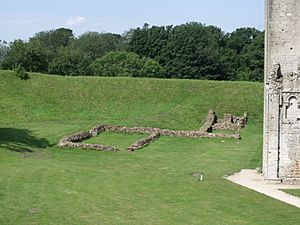
The Montalts were an important noble family. But they had few other lands in the area, and their wealth decreased. In 1327, Robert de Montalt, who had no children, sold his rights to the castle to the Crown. This meant he sold it to the king for 10,000 marks. He and his wife Emma could still live there for the rest of their lives. Another idea for the different stonework at the top of the keep is that it was completed by William d'Albini II but was falling apart by the early 1300s. This would have needed big repairs by Robert. The front part of the keep was made taller around this time. A new, pointed roof was added. A large kitchen made of timber and brick was built in the inner bailey.
When Robert made his deal with the Crown, England was ruled by Roger Mortimer and Queen Isabella of France. Isabella was ruling as regent (a temporary ruler) for her young son, Edward III. Isabella lost power when Edward removed Mortimer in a coup d'état (a sudden takeover) in 1330. But after a short time under house arrest, she lived a fairly normal life. She was still very important as the King's mother. Edward gave Isabella several royal castles, including Castle Rising. Robert had died in 1329. In 1331, Emma sold her rights to the castle to Isabella for £400.
From then on, Isabella used Castle Rising as one of her main homes until she died in 1358. Isabella was very rich. The King gave her a yearly income of £3,000, which grew to £4,000 by 1337. She lived a grand life in Norfolk. She had minstrels, huntsmen, and grooms. Edward and the royal family visited her at least four times. Even with her large income, Isabella owed money to local merchants near the castle. Around the time she took over, new buildings were added in the central bailey. These included a living area, a new private chapel, and service buildings. The old kitchen was still used. The great hall got a new roof. Isabella lived in the new west area, using the keep only for formal events or for important guests. A brick wall around the inner bailey might have been built then for more security.
The castle then went to Isabella's grandson, Edward the Black Prince. Edward III had decided in 1337 that his son would get the castle after Isabella died. This included the surrounding land and some money from tolls in King's Lynn. These tolls brought in about £100 a year. The King made the castle a permanent part of the Duchy of Cornwall. This is an estate traditionally for the Prince of Wales. The Prince repaired the castle in the 1360s. He spent £81 on fixing the "Nightegale Tower" in 1365. We don't know which part of the castle this was. The Prince died in 1376. The Duchy of Cornwall went back to the Crown. During this time, Castle Rising seemed to be kept in good shape. Orders were given several times in the 1380s to gather local soldiers. This was to prepare for a possible French invasion. The castle might have had two cannons. If Isabella didn't build the brick wall around the inner bailey, it might have been built during this time.
Under King Richard II, the castle changed hands many times. This was despite Edward's rule that it should always be part of the Duchy. Richard's government gave the castle to John, the Duke of Brittany, in 1378. This was in exchange for the Château de Brest. Richard later gave the castle to his uncle Thomas, Duke of Gloucester, in 1386. Then he gave it to another uncle, Edmund, Duke of York, in 1397. Soon after Richard was overthrown, courts said these gifts were illegal. The castle was returned to the Duchy in 1403. At that time, the future Henry V owned it.
Decline and Revival: 1400s – 1800s
In the 1400s and early 1500s, Castle Rising was still owned by the Duchy of Cornwall. King Henry VI used the castle's defenses in 1461 during the Wars of the Roses. But it became more important for hunting. The person in charge of the castle was often also in charge of Rising Chase. This was the parkland around the castle. The castle might have been a fancy place then. But its facilities were not as grand as other hunting castles. Important visitors included Mary Tudor, Queen of France, and Charles Brandon, the Duke of Suffolk.
Small repairs were done, like to the castle bridge. But the castle slowly got worse. The old kitchens were removed in the early 1400s. A new, bigger kitchen was built. But once built, the new kitchens and other buildings were left to decay. Reports in 1482 said the buildings were no longer waterproof. A survey around 1503-1506 said the castle was "evyll repayred" (badly repaired). It noted that the keep's roof was rotten. This survey suggested finishing repairs on the bailey buildings. But it said repairing the keep might be too expensive.
Despite these problems, new building work happened around this time. The southern part and the kitchen were torn down. They were replaced with new guest rooms and stables. But these new buildings were not very strong. Problems came back. A survey between 1542 and 1543 said that, except for the new rooms, the castle was in "greate ruin and decaye" (great ruin and decay). The keep's roof had fallen in, and probably the floors of the great hall too. The survey estimated £100 was needed to fix the crumbling walls around the inner bailey. Around this time, the front part of the keep was changed to form separate, smaller rooms. Later, a passage was dug out of the walls to connect these rooms to the kitchens in the keep. This bypassed the keep's now floor-less rooms.
In 1544, King Henry VIII gave the castle to Thomas Howard, the Duke of Norfolk. But the property continued to decline. By the 1570s, rabbits had infested the castle and its earthworks, causing much damage. A survey suggested fully fixing the castle would cost £2,000. It also said that if it were torn down and sold for its materials, it would only bring in £66. By the end of the century, most buildings in the inner bailey were cleared. The new rooms, most of the west area, and the old Norman chapel were torn down. Only the ruined keep, latrines, and newer chapel remained. The foundations of the old chapel were slowly covered by the earth defenses.
In the 1600s, the ground floor of the keep was dug up. This was probably to get gravel for roads or paths. The rooms in the front part of the keep were abandoned and also fell apart. In 1644, the lands around the castle were no longer used as a park. In 1705, stone was taken from the castle to help repair a nearby sluice gate.
Modern Times: 1800s – Today
The Howard family continued to own Castle Rising. In the 1800s, Mary Howard and her husband Fulke Greville Howard inherited it. Fulke started restoration work. He dug out the keep's basement in 1822 and fixed some stonework. The ground level of the inner bailey, which had risen over the years, was lowered by about 1 meter (3 feet). According to archaeologist Henry Harrod, this took thousands of loads of earth to remove. Much medieval archaeological evidence was lost. But the work uncovered the old Norman chapel. Harrod excavated the building in 1851. Mary continued the excavation work after Fulke's death. She also restored the chapel's stonework.
At first, people thought the chapel was Anglo-Saxon and had been buried when the earthworks were built. A debate then happened between William Taylor, who thought it was Anglo-Saxon, and Harrod, who said it was Norman. The issue was settled later in the 1900s when the Norman date was confirmed. By 1900, the castle was open to the public. A caretaker lived in a part of the keep that had been re-roofed and turned into an apartment.
By 1958, the castle was in poor condition. The Ministry of Works took legal care of the site, though the Howard family still owned it. Conservation work happened in the 1960s, making the keep's stonework stable. Archaeological studies were then done. They focused on the keep in 1970, the church and earth defenses in 1971 and 1972, and the inner bailey from 1973 to 1976. This research involved digging and recording old remains. Like other castles studied then, the site was preserved as a monument. Grass lawns were laid around the remaining stonework and foundations. More digging happened in 1987 when the ticket office was built.
English Heritage took over the castle in 1983. They continued to run it as a tourist attraction. Today, the castle is protected by UK law as an ancient monument and a grade I listed building. It is still cared for by English Heritage. But since 1998, its owner, Baron Howard of Rising, has managed it.
Castle Design and Surroundings
The Castle's Landscape
Castle Rising was built in a carefully planned landscape. The town of Castle Rising was moved to its new spot when the castle was built. The town seemed to be laid out in a grid pattern, possibly with ditches around it. The castle was placed just behind it, similar to New Buckenham and Malton Castle. A dovecote (a place for doves) and a religious house were built nearby. Both were important symbols of power at the time. They were seen as key parts of a well-established castle.
The castle's deer park, which joined the larger Rising Chase, was behind the castle. This was similar to Devizes Castle. The castle connected the town and the park. The great hall in the keep faced the town. The lord's private room overlooked the park. This created a symbolic division between the public and private parts of the building.
Rising Chase was about 16 miles (26 km) around, covering about 20 square miles (52 sq km). It used land that was not good for farming. This might have helped its design. The heathland and light woods south of the castle were perfect for deer. The park was also designed to look beautiful. Its boundaries stretched beyond the horizon when seen from the keep. This was like Framlingham, Ludgershall, and Okehampton Castles. The park would have provided deer meat and other things. But it was probably more for show than for practical use. It included an open grazing area in the center, meant to be seen from the castle chamber. The castle also had a large rabbit warren. This was an important source of food and fur back then. It stretched 5 km (3 miles) southwest from the castle.
Castle Architecture
Baileys and Gatehouse
Castle Rising has two rectangular baileys (outer courtyards) to the west and east. It also has an oval inner bailey in the middle. Each has its own strong earth defenses and ditches. The earthworks cover 5 hectares (12 acres). Archaeologists Oliver Creighton and Robert Higham say they are among the most impressive in Britain. The inside of the western bailey has been leveled to form a platform. It is no longer directly connected to the rest of the castle. The eastern bailey is 82 meters (269 feet) by 59 meters (194 feet) across. It acted as a protective area, covering the entrance to the inner bailey.
A stone bridge connects the eastern bailey to the inner bailey. It is 24 meters (79 feet) across. Some of its original stonework is still at its base. But the rest has been rebuilt many times. The bridge leads to a stone gatehouse, built around 1138. When first built, it was much taller and longer than it is today. It originally had a portcullis (a heavy gate). A stone barbican (an outer defense) was later built outside it for more protection.
Beyond the gatehouse is the inner bailey. It is a ringwork (a circular earthwork) 73 meters (240 feet) by 60 meters (200 feet) in size. Its circumference is 320 meters (1,050 feet). The banks are now 18 meters (59 feet) high from the bottom of the ditch. They were originally only half this height. We don't know what was on top of this bank when it was first built. It might have been a wooden fence or a timber wall. Some remains of the 14th-century brick wall have survived along part of the bank. This wall was built on an extra 1 meter (3 feet) layer of limed sand for stability. Three towers were built along the walls in the medieval period. Two of them have left marks in the earth banks. The location of the third is unknown.
The main building in the inner bailey was the great keep. But it also had a Norman chapel. From at least the 1300s, it had a group of smaller living and service buildings. The visible stone foundations on the north side of the keep belong to the chapel and buildings built for Queen Isabella around 1330. The bailey well can still be seen.
On the north side of the bailey are the remains of the Norman chapel. It had a nave (main part), a square tower, and an apsidal chancel (altar area). These were 12.7 meters by 6 meters (42 ft by 20 ft), 4 meters square (13 ft square), and 4.6 meters by 4 meters (15 ft by 13 ft) respectively. It was built from local grey sandstone. Roman tiles from nearby villas were used for its roof and in its walls. The tower would have had a church bell. The casting pit for this bell is buried under the nave floor. A stone bench runs around the base of the walls. In the 1800s, there was also a stone base for a font in the nave, but it is now lost. A piece of early medieval graffiti, possibly showing a Norman soldier, is on the south outer wall. A fireplace was added to the chapel during the Tudor period. But it was only used for a few years before being abandoned.
The Great Keep
Historians Beric Morley and David Gurney believe Castle Rising has "one of the finest of all Norman keeps." It is an early example of the longer, oblong shape of these buildings, called a hall-keep. It would have taken huge resources to build. From the outside, it looks like Henry I's keeps at Norwich and Falaise. Norwich seems to have inspired the design. Rising's inside layout was probably also based on Norwich. By copying Norwich, which was the only royal castle in the county, Castle Rising might have shown D'Albini's loyalty to the King during the difficult years of the Anarchy.
The keep is built from layers of local, brown carrstone rubble. It has oolite ashlar (cut stone) facings. It is strengthened with timbers inside the stone walls. Its main body is 24 meters (79 feet) by 21 meters (69 feet) wide. The walls are about 15 meters (49 feet) high. A front building runs along the east side. It has strong pilaster buttresses. These give the keep an "impression of strength and dignity," according to Sidney Toy. The corners have buttresses that form four turrets (small towers). There are many Romanesque details on the outside. This includes arcading (a series of arches) along the west side and decorative stonework on the front building.
The inside of the keep is divided by an inner wall for strength. This division runs north–south. The basement has two main parts. The north room is 18 meters (59 feet) by 8 meters (26 feet). Pillars support the great hall above it. The south room is 18 meters (59 feet) by 5 meters (16 feet). The front building leads from the ground to the first floor. There is a passage 2.4 meters (8 feet) wide with 34 steps. It goes through three arched doorways. At the top is a waiting room. The windows are a mix of Tudor and newer additions.
On the first floor is the great hall, 14 meters (46 feet) by 7 meters (23 feet). It now has no floor and is open to the sky. Its original entrance was blocked by a chimney when the front building was made into a separate apartment in the Tudor period. A new entrance was put into the castle wall. The fireplace itself was filled with Tudor tiles around 1840. A passage dug out in the Tudor period leads to the kitchen and service rooms. On the southern side is the great chamber. It has a large, original 12th-century fireplace. It has a mix of original three-lobed windows and 19th-century additions. At the far end of the great chamber is a fancy chapel. It has Norman arches and decorative work. The keep was originally built to be mostly self-contained. It would not have needed many extra buildings to be a home.
The second floor of the keep has limited space. It has only one small room above the chapel. This room was possibly used by the chaplain or castle guards. The front building later got an extra room on this level, 4.8 meters (16 feet) by 4.8 meters (16 feet). This room was lived in longer than the rest of the keep. It has a 19th-century fireplace. The top 3.7 meters (12 feet) of the keep's walls have a different design. As mentioned, this might be from a final building phase between 1200 and 1230. Or it could be from repairs and renovations shortly after 1300.
Purpose and Meaning
Many historians in the 1900s emphasized Castle Rising's military strength. R. Allen Brown, for example, said that "defense... was the overwhelming consideration" in its design. He argued the keep would have been a last refuge during a siege. Beric Morley and David Gurney believe the castle's military strength would have impressed people at the time. Sidney Toy suggested the front building would have been a good defensive feature. It would let defenders attack intruders going up the stairs. Morley and Gurney called it "a deadly and near impregnable approach to the castle's interior."
However, the defensive qualities of Castle Rising have been debated. Historian Robert Liddiard argues that the large windows would have been a big weakness. It would have been easy to shoot arrows through them from the bailey. George Garnett has questioned the usefulness of the defensive arrow slits. He suggests they were not well placed or designed. The whole site was also overlooked by higher ground. Liddiard thinks this would have been a key defensive weakness.
Great keeps like Castle Rising's were also important for ceremonies and symbols in the 1100s. Historian Thomas Heslop called Castle Rising "a fortress palace." The keep was the palace, and the earthworks were the practical defenses. They showed the owner's high status. Owners like William d'Aubigny had often recently risen in society. They wanted to impress others with their new power.
With this in mind, Castle Rising's location might have been overlooked by higher ground. But it also made it stand out across the valley. The entire entrance to the castle was designed to show visitors the lord's importance. As they came through the gatehouse and past the earthworks into the bailey, the south side of the front building would appear. It faced the entrance on purpose. It was covered in fashionable carvings and decorations. Visitors would then walk up the stairs of the front building. They would pause in a waiting room, which was originally open to the outside. Then they would be allowed through a fancy entrance door. The doorway led into the great hall. There, the lord, possibly sitting in a special alcove, would meet the visitor.
Ceremonial Entrance



